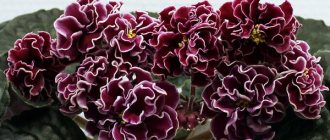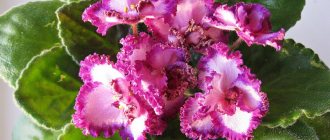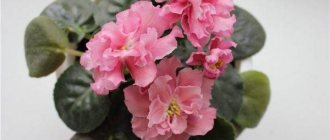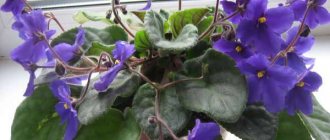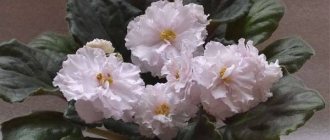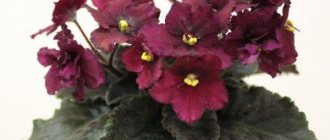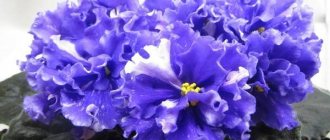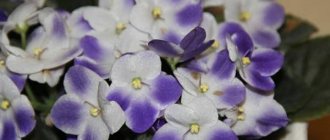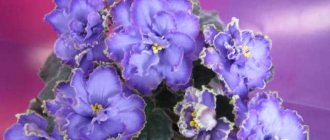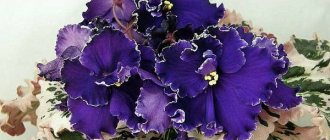Paul Sorano heads Lyndon Lyon Greenhouses, a well-known company among violet lovers. Violet varieties bred by this company have long won the hearts of Saintpaulists all over the world. LLG turned 55 this year; the company’s founder is Paul Sorano’s grandfather, Lindone Lione. Paul Sorano took over the business from Lyndon Lyon, his grandfather, in 1993. From that moment on, his life underwent changes. Today he is the author of favorite and world-famous varieties. At the invitation of the head of the House of Violets store, Vladimir Kalgin, Paul Sorano came on a visit to Moscow. His favorite colors of violets are coral, red, and dark purple. What he values most in violets are chimeric and fantasy colors. Three people constantly work in his six greenhouses, employee Barbara, he and his daughter. Also, two people work half the working day and their responsibilities include collecting orders for shipment, they... The criteria by which Paul Sorano selects seedlings are novelty, beauty, and demand. When asked what varieties he could give to Mr. Putin, he pointed to the following varieties: Optical Illusion
-for its unusual color, Tinny Bopper as the smallest, Spectasular - as the owner of large flowers
as well as Irish Flirt
which is the winner of many exhibitions. This variety, according to the breeder, is his best achievement. The perfect Saintpaulia in his opinion is a violet that has the color of a yellow narcissus. Paul Sorano lives solely by flowers and considers going to exhibitions with his flowers a vacation. His working day sometimes reaches 14 hours. Two cats, both 15 years old, live in the house with him; he does not have a wife. After visiting Russia, he visited both Moscow and St. Petersburg
and Kyiv.
His most famous selections
Playful Spectrum
As a result of the painstaking work of scientists, the classic violet with blue flowers has become the ancestor of a large number of new varieties . Violets come in a variety of shapes and shades. Double or semi-double flowers appeared. The colors have mixed with each other, now on the windowsills of avid collectors you can see violets with patterns, spots, stains, inclusions, stripes and contrasting borders. What types of violets are there? Let's take a closer look at the most popular varietal violets, described in this article.
Types and varieties of Saintpaulia, description of indoor plant
All violets were divided into several groups to facilitate orientation among the many species. There are three groups :
- collectible;
- variegated;
- industrial.
Variegated varieties are characterized by the brightest color of the leaves, which can be painted in different colors . They often have a border around the edges. The first variegated varieties produced small and simple inflorescences, but later breeders developed species distinguished by large double flowers of different colors.
Industrial Dutch violet
Industrial - intended for mass cultivation on special plantations . They are available for purchase in large quantities. Their appearance is the simplest. These plants are mainly used to decorate banquet halls and are placed in offices and government institutions. These varieties bloom actively for a long time.
Collectible
They are characterized by large inflorescences measuring from five to seven centimeters. They differ from other species in that almost all of them have large double petals of a wavy shape, painted in a wide range of colors : from snow-white to rich blue shades. The leaves also vary in color and have wavy edges.
The most beautiful and unusual varieties are collected at exhibitions. Complex collectible varieties require more time and effort to successfully grow and properly care for. Labor is rewarded with gorgeous flowering. Collectible violets include : Lemon Snow, Willodene, Gift for a Loved One and many others.
Terry violet Scandal (S. Sorano)
In a relatively short period of time since its discovery and its first appearances at world flower exhibitions, the Uzambara violet has managed to take its rightful place among plants grown indoors .
This was greatly facilitated by the compact size of the tropical beauty, the spectacular decorativeness of its appearance, the variety of shapes and coloring with all the colors of the rainbow palette.
With a strong desire, even a novice amateur will be able to master these simple rules and create comfortable growing conditions for plants. Recently, such an innumerable number of hybrid varieties and varieties of violets have been created that any gardener will be able to choose specimens in accordance with his own, even very demanding, taste.
Among the most interesting varieties of foreign selection, we can recommend the Scandal variety , which actively participates in various exhibitions and is loved by many flower growers. Next you will see detailed photos and descriptions of this variety.
Difference in names
Saintpaulia and Uzambara violet are the names of the same plant, which is cultivated at home. Saintpaulia is the Latin scientific name, and Uzambara violet is the folk name . People began to call Saintpaulia Uzambara violet because in its natural environment the plant is found in the Uzambara Mountains.
Viola is the Latin name for the violet that is grown in gardens.
Purple
Currant dessert
They take the shape of stars, they are very fluffy and semi-double. Along the edges of the petals there is a fringe of an unusual color : it resembles the shade of jam made from black currants. The velvety leaves are colored green. The variety is quite unpretentious, suitable for beginners.
Winter rose
The shape of the flowers strongly resembles pink inflorescences, which is why the variety has such a name. The petals are dark blue-violet. There is a thin snow-white edging along the edges . Small leaves are colored rich green. Winter rose conveys the qualities of the variety well.
The leaves have serrated tips and form a compact rosette of bright green. They are classified as semi-double. They grow to impressive sizes and are colored blue-violet. Along the edges there is a wide, blurry white border .
Aly's Blizzard Bunny
The snow-white flowers are small in size and strongly reminiscent of stars. The variety is classified as semi-double . The heart-shaped leaves are a rich green color. This species is very popular among amateur gardeners.
Snow lace
The variety is characterized by lush double flowers of a snow-white hue. There is a bluish spot in the center . The edging of the petals shines with a barely noticeable greenish tint. It blooms very actively and luxuriantly. The leaves are colored light green.
The bride's bouquet
It was bred by Russian breeder Konstantin Morev. Large delicate white flowers in the shape of a star with wavy edges are very similar to a wedding bouquet . Blooms profusely. The petals have an even color, there are no inclusions or patterns.
A variety of fabulous beauty. Large double flowers consist of rich pink petals, along the edges of which lilac inclusions are scattered . The wavy edges of the petals are decorated with a thin light green border. Flowers bloom on powerful peduncles. Blooms profusely if the necessary conditions are met.
The variety was released in 2011. Blooms large double flowers of a rich pink hue . Along the edge of the petals there is a lilac border with a thin snow-white line. The leaves are dark green. Looks great on the windowsill.
The foliage is colored green. Large double flowers resembling a ball bloom in the middle of the rosette. The petals have a wavy edge. The flowers are located very close to each other, which creates the impression of a huge bouquet . Very popular at exhibitions. Many people acquire leaves of this variety.
Lilac beauty
The variety is distinguished by large purple flowers with speckles of rich lilac color in the center. There is a dark border at the edge of the petals. The flower stalks are powerful, the rosette of regular shape consists of round leaves . This variety is easy to care for and is suitable for beginners and even children.
Favorite daughter
The flowers are a rich lilac color with a dark purple border. The serrated leaves are round in shape and emerald green in color . The reverse side has a clear raspberry tint. Flowers are born small and dark. As they develop, they become lighter. It can lift leaves up, so it needs a lot of space on the windowsill. Beautiful and lush flowering almost always pleases the gardener. They bloom for two to three weeks.
Read also: The best varieties of Dutch onions
Blue Dragon
A widely known variety of Sorano selection. Almost all collectors have this variety. Popular for its large, soft blue flowers . A white-greenish border stretches along the edges of the petals. The variety is quite capricious. It needs a natural source of light and does not tolerate agricultural errors.
Blue Danube
Bred by Russian breeders. It is characterized by large flowers that reach five centimeters in size. The petals are colored pale blue. Matte leaves with wavy edges have small denticles at the end . This variety needs good lighting and proper watering. The abundance and duration of flowering depends on temperature.
Blue Lagoon
The variety is characterized by large semi-double flowers of a rich blue hue, reminiscent of a star shape. It has a blue spot in the center, and a purple border runs along the edges. When there is insufficient light, it raises the leaves upward . Flowering duration is two months. Easy to care for, even a beginner can grow it.
Variegated
lemon snow
The flowers are painted snow-white with lemon-colored rays. The middle and edges have a bluish tint. The leaves are variegated and painted a rich green color . There is a white border along the edge of the leaf.
Willodene
A variety with unusually beautiful variegated leaves. Peach flowers with a greenish edge are not the main attraction. At exhibitions, attention is paid to the wavy leaves, colored emerald , diluted with pink and white spots.
Gift for a loved one
Of particular value are the rich green leaves with sharp tips and pink-white edging . The flowers are blue. There is a purple border along the edge. Enjoys great success at exhibitions. Quite an unpretentious variety.
Ampelous violets are used for growing in hanging pots. They decorate hanging flower beds and gardens. They have several growing points, long stems hanging down, and a large number of side shoots. The most popular varieties of ampelous violets are Trinket Summer Skyes with rounded green leaves and blue flowers and Robs Humpty Doo with light leaves and snow-white flowers.
They need a lot of light. They are able to bloom throughout the whole year . In winter, the plant is provided with additional lighting.
The rosette of miniature violets does not exceed fifteen centimeters in size . At the moment, about two thousand varieties of mini-violets are known.
Many collectors only collect miniature violets. Caring for miniature violets has some features : they are less whimsical than their larger counterparts.
Among the mini-varieties, Avatar can be distinguished with simple semi-double flowers of a soft blue hue and variegated leaves. Flower growers are also attracted by a delicate variety called My Angel . Simple flowers on powerful peduncles are colored pink. The leaves are soft green in color and have a wide snow-white edge.
Violet Scandal (S. Sorano)
Authorship of the variety
This violet represents the successful completion of the scientific developments of one of the most sought-after masters of the foreign school for breeding new varieties of Saintpaulia - American breeder Paul Sorano and his enterprise Lyndon Lyon Greenhouses.
The variety was introduced to the global community of violet growers in 1993 , and has not yet lost its varietal qualities and can rightfully be called a retro variety.
Taxonomy
According to the taxonomic classification, violet "Scandal" belongs to the genus Saintpaulia of the Gesneriev family . Considering the size of the leaf rosette, the variety is described as a standard type, the shape of the corolla indicates the “star” type, and based on the fullness of the flower with petals, Saintpaulia can be characterized as a terry variety.
Characteristics of appearance
Saintpaulia independently forms an aligned rosette from a small number of sheet plates according to the standard type. The bushes grow quite quickly and without any problems, forming a neat outline and compact configuration.
Violet leaf blades are different:
- elongated – heart-shaped;
- a brightly defined venation pattern of a light green hue;
- rounded - notched serration of the side edges;
- quilted surface structure;
- tonality of summer greenery with a silver color scheme on the reverse side.
The lower leaves tend to have slightly elongated petioles.
Flowering occurs in a cap type with the formation of a large number of medium-sized buds, opening with corollas of terry fullness of the “star” type. The volume of each flower increases due to the waviness of the petals and the slight corrugation of their contours.
The color of the corollas is distinguished by iridescent shades of burgundy and fuchsia with a significant concentration of color closer to the wavy edge of the petals, set off by a thin white ribbon edging.
A feature of the variety is the ability of the corolla petals, under certain conditions, to transform their color into an almost black tint with the addition of greenish reflections.
The violet consistently retains its varietal qualities, but occasionally sports with violet coloration of the corollas without darkening and white edges appear.
What varieties are cultivated at home?
At home, simple violets of the industrial group, variegated and collection ones are grown. Beginners are advised to start simple violets to gain experience in caring for them. An experienced florist can already grow complex breeding varieties. A huge number of species are grown at home. Experts have developed about thirty-two thousand varieties of indoor Saintpaulias, differing in many parameters : color, shape, leaf structure and rosette.
About twenty species of Saintpaulia grow in the wild. In natural conditions there are :
Velvet Saintpaulia
On the front side the leaves are painted green, and the back side has a reddish tint . The inflorescence is made up of purple flowers with a dark central part.
Violet flower Saintpaulia
Short stems bear blue-violet flowers and rich green heart-shaped leaves. The diameter of the rosette can reach sixty centimeters.
Saintpaulia Grote
Belongs to the ampelous varieties. The pubescent leaves take on a rounded shape . The lilac-blue flowers do not grow more than two and a half centimeters.
Care in indoor culture
Violet "Scandal" has special requirements for keeping in home collections, which should be taken into account when carrying out plant care regimens.
Growing conditions
When determining a place for violets, preference should be given to eastern and western window sills.
On south-facing windows the plant will need shading, on the north side - additional lighting.
Watering rules and feeding features
Violet loves very careful watering with a measured amount of water after drying the top part of the soil.
Watering possible:
It is permissible to apply fertilizers once a month with mandatory control of the amount of chemical elements in them at each phase of Saintpaulia development.
Illumination
Violet Scandal blooms beautifully both on a windowsill in daylight and on a shelf indoors.
Room temperature
The ideal temperature indicators for violets are considered to be +20 + 24°C . In winter, their decrease by 2–3 degrees is possible.
Temperature of violet content.
When controlling the temperature in the room, regular ventilation , during which the violet should be protected from exposure to drafts.
Change in Humidity
You can increase the humidity for comfortable growth of Saintpaulia by installing various types of humidifiers in the room or by regularly spraying the air within the reach of the plants.
Soil requirements
When choosing the soil in which the violet will grow, keep in mind that for its successful development, a nutrient substrate containing a complex of chemical elements, with a permeable, sufficiently aerated, light structure is suitable.
A drainage system is required in the flowerpot , and it is also possible to add particles of drainage materials and activated carbon to the soil.
The need for hygienic cleaning
Violets should be cleaned periodically, cutting off diseased and damaged leaves, dried buds and mature children.
Nuances of the transplant process
Transplantations of the variety are possible only if clearly necessary . Rejuvenation can be carried out after five years by rooting the upper part of the bush.
Useful properties of violets
Indoor violet can not only please the eye of the gardener, but also help with various diseases. It has a beneficial effect on the body during kidney inflammation, bronchitis, joint pain and atherosclerosis . A decoction is prepared from a Saintpaulia leaf poured with boiling water and added to tea. Take it within 24 hours. You can bathe children in violet decoction. This method will help cure scrofula, rickets, eczema and skin rashes. Violet tinctures help with tinnitus after childbirth. With the help of a violet leaf you can get rid of insomnia and neuroses.
The plant contains toxic substances that, if used incorrectly, poison the body . Between courses there is a break of a month.
It is difficult to select the best varieties of Saintpaulia given the huge variety. The most beautiful, of course, are the collection varieties . The most popular among gardeners are Winter Parasol, Adonis, Rococo Pink and many others.
Reviews
Anatoly, Volgograd. “I bought the baby Playful Spectrum and was very disappointed. I can’t say that it didn’t bloom brightly or poorly. But it bloomed completely out of character, with a chimeric color. The rosette is very even, hugs the pot beautifully and looks very cool. The flowering is very abundant, even the first one, the flowers are very large, and the peduncles do not stretch out.
The variety has no downsides for me. But the fact of buying a sport instead of the desired sport spoils the picture a little.”
The color of flowers attracts many gardeners.
Ekaterina Poleshchuk. “I bought a blooming Playful Spectrum rosette. For a very long time she pleased me with flowers. Then I transplanted it onto wick watering and placed it with other plants on the windowsill. The second flowering was very surprising. The flowers turned almost blue with some splashes of pink. I started digging for information and moved it to a cooler and less lit place. Subsequent flowers are entirely according to the variety. But when breeding, I just can’t get a baby according to the variety, all sports, well, at least different, and now instead of one new variety I have as many as five (mother’s rosette and four children’s sports).”
The best varieties of Sorano violets
Usambara violets are very often associated with America. However, many lovers are far from understanding what the Saintpaulia culture is like in the United States. For American breeders, this is a business in breeding their own varieties. That is why the approach to newly created hybrids is commercial. “This variety is interesting, they will buy it, but this one is uninteresting, but it can be left in the catalog of new products for variety.” The result of this approach is that not all varieties of American selection are attractive. In our market, the words “foreign novelty” sound fascinating. New varieties are ordered, advertised, and people fight for them. At the same time, domestic selection is sometimes not paid attention to.
Read also: The best varieties of late apples
In the United States, interest in violets is steadily declining. Ours is growing. This is mass, popular love. Americans are pragmatic, Russians are spiritual. They will manage without the most necessary things, but not without a painting, a book, or a favorite plant. Americans have a typical mindset; they want a simple, unambiguous recipe for all occasions. Russians have their own special opinion on everything. For example, each gardener has his own soil composition for his favorite plants. Residents of the United States do not understand this - why look if there is already a ready-made, tested, optimal option?
Americans strive to fit everything into a certain stereotype, while Russians always strive to invent something new and unusual. Thus, Americans are very scrupulous about the symmetry and compactness of the rosette and the neat appearance of the foliage. Kent Stork instructed his student: find good leaves and “attach” flowers to them. As a result, decades are spent selecting the “impeccable” variety. Seedlings are crossed with each other, propagated again and again by leaf cuttings to check the shape of the rosette, and so on. Americans reject the hybrid if the edge of the leaf is strongly curled, that is, they fight against what decorates the violet. Moreover, it is known that the wavy edge of a flower usually genetically correlates with the wavy edge of a leaf. But Americans manage to produce violets with fringed flowers and smooth, straight leaves! Another example of American taste: the abundance of varieties with soft fantasy is amazing. The preferences of Russians are opposite: the more contrasting the pattern, the better and more beautiful it seems to them. I know from myself: sometimes you walk around a store, looking at the windows with new products, and you can’t choose anything - all the violets merge into one lilac-pinkish background with small, expressionless specks of fantasy. There are many more such examples of differences in approaches and tastes.
Special talk about the American soilless mixture for violets (perlite, vermiculite, high-moor peat in equal parts). If we talk “by science”, then nothing can grow in such a mixture. Perlite and vermiculite are good mineral supplements. But if there are more than half of such rippers in the soil (60 percent), then the balance of nutrients is disturbed, and the plants develop a characteristic yellowing of the lower leaves. But it is interesting that Americans do not grow Saintpaulia in such a substrate, although they recommend it as an ideal from the pages of their magazine. At first, they managed to use a mixture without peat at all (50% vermiculite and 50% perlite), then, on the contrary, they switched to growing in only peat (vermiculite disappeared from sale, and perlite began to be produced of poor quality). Recently we have returned to using rippers. Thus, P. Sorano uses a ready-made substrate, to which perlite has already been added in small quantities.
Another interesting example: many people do not know that for Americans, soilless mixture and wick irrigation are inseparable from each other. But, naturally, watering through a wick is a delicate matter that requires attention and accuracy. In the case of constant humidification, the water rises upward all the time due to the capillary effect. On the pages of the African Violet Magazine there is a heated debate going on: what forms in the upper part of the pot - mold, fluoride salts or some other deposits. It turns out that Americans regularly clean off and throw away the top 2 centimeters of soil. So much for the perfection of American technology!
It never ceases to amaze us that Americans achieve their excellent results through simple painstaking work in the most ordinary greenhouses, facing the same problems that arise in our country. I had to work in the conditions of our old “antediluvian” greenhouses. In summer, plants suffered from burns at high temperatures and high humidity, in winter - from poor lighting and frost. The plants were watered hastily with a hose. It seemed to me that it was impossible to grow violets in such conditions. And so I was surprised to learn that the P. Sorano company, which supplies the whole world with its masterpieces, uses the “old fashioned” method of watering from a hose! Moreover, the trays with the planted plants are also filled with water, and the workers are forced to lift them to remove excess water. As they say, technology is on the verge of fantasy!
No less touching is the story of P. Sorano about how he fought thrips in greenhouses. For several years in a row, every Saturday for 4 hours he had to treat all the plants with insecticides. In the process of performing this backbreaking work, the thought more than once came to his mind to quit violet breeding. Perhaps this would have happened if Paul had not eventually found an effective drug, Conserve.
The entire history of hybrid violets is connected with the USA, and American breeders have incomparably more experience than we do. In America there is a galaxy of strong breeders working in different directions. They have much more opportunities - they have entire greenhouses at their disposal, not apartments. Such a scale allows them not only to create a huge number of varieties, but also to conduct long-term research into new areas of breeding. Russian hybridizers are in less advantageous conditions; almost all of them are amateurs. They care little about the situation. They breed varieties for their own pleasure, not thinking about commerce in the first place.
Read also: The best varieties of raw smoked sausage
There are many circumstances that do not work in favor of domestic selection. Take a random catalog of any Moscow breeder and you will see the absolute predominance of American varieties. The psychology of the masses is driven by inertia. They will buy Sorano violets because they bought them ten years ago. The market is flooded with American varieties. The average person, who can purchase any violets, since the assortment allows, does not care at all whether domestic violets exist at all, even if they are superior to American ones. In addition, the Russian person’s sense of patriotism is not as developed as that of other peoples. Therefore, Russians will buy overseas varieties, not Russian ones. And American violets will hold the palm for a long time here and throughout the world.
Many people think that Saintpaulia breeding has exhausted itself. However, despite the apparent diversity of modern violets, not everything has been said in their selection. There are no rich yellow varieties, few pure red, brown, completely black. The shape of the flower remains completely unplayed, which conceals a reserve of diversity. There are few Saintpaulias that are multi-fantasy and multi-colored. Even in the variety of chimeras, which have been bred in America for a long time, the last word has not yet been said.
And therefore, at the beginning of each year, Russian violet lovers will look with undisguised curiosity at the websites of American breeders to see new varieties there.
Features of life
The life processes of the Scandal violet are similar to the development of other varieties of Saintpaulia, but with regard to care regimes, the variety is considered finicky, having several special nuances for keeping in home collections.
Development in indoor culture
When all necessary care regimens are correctly followed, the violet develops at a rapid pace, independently forming a beautiful rosette. Among gardeners, the variety is especially valued for its compact bush structure. But with a large number of buds, the leaves may curl towards the flowerpot.
When growing a variety, you should pay particular attention to the following aspects:
- watering the violet should be strictly dosed, since it does not tolerate overflow;
- transplants should be done when absolutely necessary - Saintpaulia has a complex recovery process.
Violet blooms for a long time and is very lush - there are much more buds than leaves. The double structure of the corolla is formed as the number of flowerings increases; the first flowers can be almost single or slightly semi-double.
The size of the flowers largely depends on the number of buds formed in the cap - the more corollas, the smaller they are. The rest intervals between flowering for this variety reach four months.
Willingly reproduces with children.
Rosette formation time
Violet “Scandal” spends quite a long time in the process of growing up, since the children of this variety develop very slowly. The first flowering of Saintpaulia when propagated by leaf cuttings, and therefore its maturation, occurs after about a year.
The first flowering occurs after one year.
Reproduction methods and features
To obtain a young specimen of Saintpaulia, flower growers use two methods:
- separate and root the baby formed on an adult bush;
- Children receive them using leaf cuttings and then root them in their flowerpots.
You should not propagate varietal violets by seeds , since Saintpaulia varieties in most cases are hybrid forms. And hybrids do not retain the characteristics of the variety when propagated sexually.
The varietal characteristics of violets remain stable when Saintpaulias are rejuvenated.
Flowering in different temperature conditions
With an optimally comfortable microclimate, the violet lays many buds and blooms in very lush caps.
The coincidence of the moment of flowering with elevated temperatures can shift the timing of flowering. An increase in temperature already at the moment of flowering affects the behavior of peduncles - they fall on the leaves.
Characteristics of peduncles
Scandal violet is distinguished by the formation of strong flower stalks on short stalks , each of which supports up to five corollas.
Flowering type
With careful adherence to all care regimens and creation of a comfortable microclimate for the violet in indoor cultivation, the bush is able to form a voluminous cap of corollas that are spectacular in shape and original in color.
Bud lifespan
Varietal specimens of violets can bloom within three months , maintaining the freshness and decorativeness of the flower cap. Moreover, each individual Saintpaulia flower can maintain its fresh appearance for up to one and a half months.
latest comments
- And my favorite photo 4 hours 6 minutes ago
- One of the interesting seedlings from 4 hours 7 minutes ago
- There will be photos of 2 different ones 4 hours 12 minutes ago
- Polina!) Better late than 5 hours 51 minutes ago
- Thank you! 6 days 22 hours ago
- I understand your desire for 6 days. 22 hours ago
- Thank you very much! 1 week 2 days ago
- Beauty! 1 week 2 days ago
- Beauty! 1 week 2 days ago
- Alina, thank you for 1 week 6 days. back
- I love watching yours 2 weeks 2 hours ago
- By the way, I wanted to say something 2 weeks 19 hours ago
- Polina, thank you. Glad 2 weeks 1 day ago
- Tanya, beauty, as always! 2 weeks 1 day ago
- Couldn't compress photo size for avatar 2 weeks 2 days ago
- One day 6 violets have brown spots and burns on their leaves 2 weeks 3 days ago
- Tatyana, thank you very much!)) 3 weeks 6 days. back
- Hodss-Pelmeshek (conditional) 3 weeks 6 days. back
- Hodss-Pelmeshek (conditional) 3 weeks 6 days. back
- Hodss-Pelmeshek (conditional) 3 weeks 6 days. back
Comments
Nice to see Polina in this
Author: Alina Akzigitova , Almetyevsk, January 28, 2016 - 11:55 editor | textile dolls To: Evgenia Fedoryachenko. To the topic
It's nice to see Polina in this flower paradise!
- Login or register to post comments
Alina, did you “go” along
Author: Polina , Columbus, January 28, 2016 - 22:04 To: Alina Akzigitova. To answer
Alina, did you follow the link? Yesterday I read it with interest; I had already forgotten what a pleasant trip it was. This was in 2011!
- Login or register to post comments
Yes, Polina! I was
Author: Alina Akzigitova , Almetyevsk, January 29, 2016 - 10:03 editor | textile dolls To: Polina. To answer
Yes, Polina! I was interested in reading and seeing your article again. I miss your stories.
- Login or register to post comments
Features of flowering, growth and reproduction
The rosette grows quite quickly ; by the age of one year, most of the children begin to bloom.
For a greater likelihood of getting children of the correct varietal flowering, it is better to propagate by stepsons, but this method does not guarantee 100% success, because the variety is very sporty.
It blooms with a cap, especially if you allow enough foliage to grow . Peduncles:
- Short;
- Strong with a lot of buds;
- Reach up;
- But with abundant flowering, the outer ones may fall a little on the leaves.
The flowers last quite a long time , from a week to two, while they bloom in a chain, the old ones wither and new ones bloom, which ensures a fairly long and abundant flowering.
The color of flowers strongly depends on the temperature regime and can vary from pink with an eye without a fantasy - in a very cool place with a lack of light, to blue, sometimes even without an eye - in extreme heat and plenty of light.
Important! When buying Saintpaulia Playful Spectrum, it is better to take flowering, mature rosettes. Ideally, find an individual that blooms for the second or third time, then the likelihood of getting into the sport is minimal.
